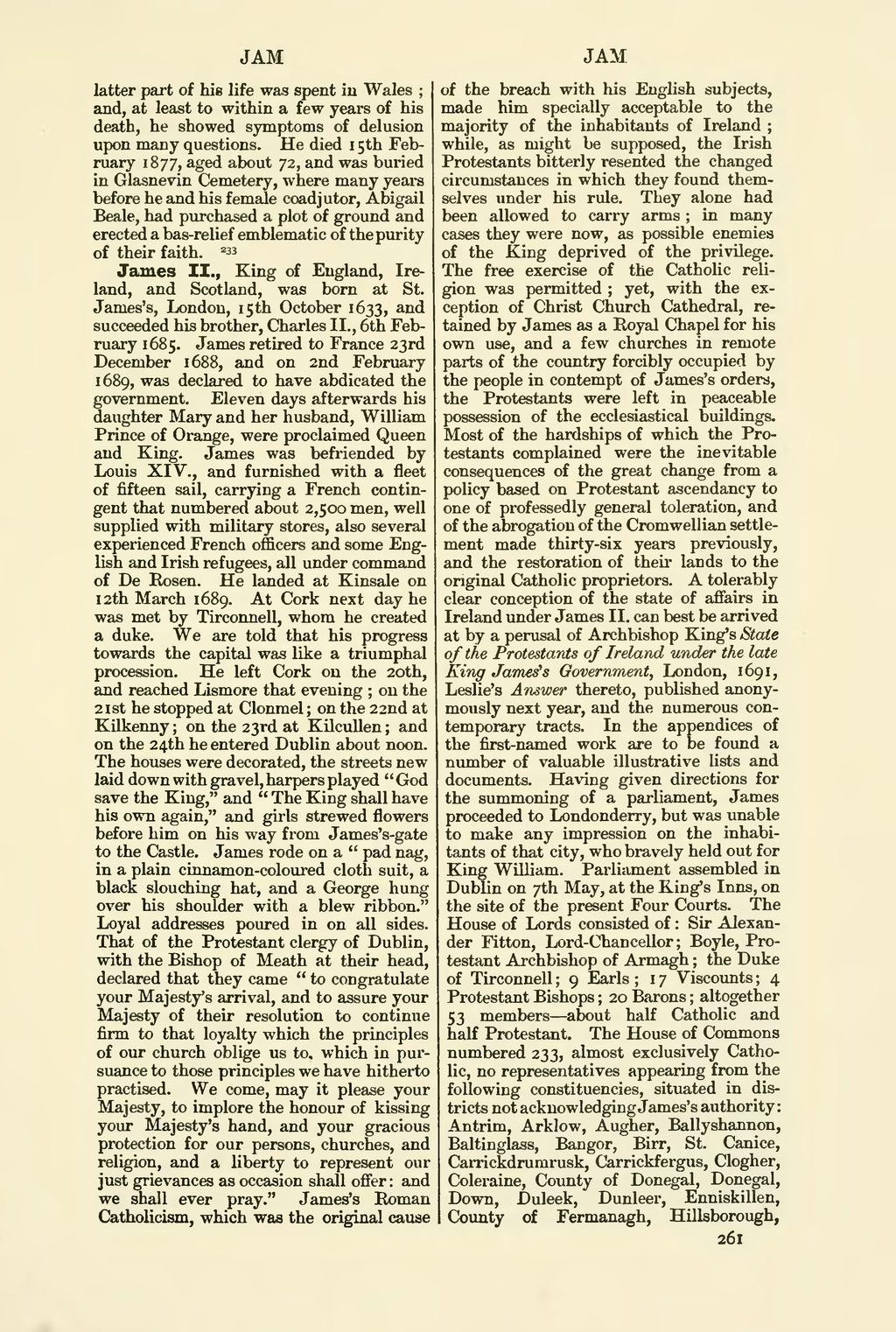latter part of his life was spent in Wales;
and, at least to within a few years of his
death, he showed symptoms of delusion
upon many questions. He died 1 5th Feb-
ruary 1877, aged about 72, and was buried
in Glasnevin Cemetery, where many years
before he and his female coadjutor, Abigail
Beale, had purchased a plot of ground and
erected a bas-relief emblematic of the purity
of their faith.
James II., King of England, Ireland, and Scotland, was born at St. James's, London, 15 th October 1633, and succeeded his brother, Charles II., 6th Feb- ruary 1685. James retired to France 23rd December 1688, and on 2nd February 1689, was declared to have abdicated the government. Eleven days afterwards his daughter Mary and her husband, William Prince of Orange, were proclaimed Queen and King. James was befriended by Louis XIV., and furnished with a fleet of fifteen sail, carrying a French contingent that numbered about 2,500 men, well supplied with military stores, also several experienced French officers and some English and Irish refugees, all under command of De Rosen. He landed at Kinsale on 12th March 1689. At Cork next day he was met by Tirconnell, whom he created a duke. We are told that his progress towards the capital was like a triumphal procession. He left Cork on the 20th, and reached Lismore that evening; on the 2 1 st he stopped at Clonrael; on the 22nd at Kilkenny; on the 23rd at Kilcullen ; and on the 24th he entered Dublin about noon. The houses were decorated, the streets new laid down with gravel, harpers played " God save the King," and "The King shall have his own again," and girls strewed flowers before him on his way from James's-gate to the Castle. James rode on a "pad nag, in a plain cinnamon coloured cloth suit, a black slouching hat, and a George hung over his shoulder with a blew ribbon." Loyal addresses poured in on all sides. That of the Protestant clergy of Dublin, with the Bishop of Meath at their head, declared that they came " to congratulate your Majesty's arrival, and to assure your Majesty of their resolution to continue firm to that loyalty which the principles of our church oblige us to, which in pursuance to those principles we have hitherto practised. We come, may it please your Majesty, to implore the honour of kissing your Majesty's hand, and your gracious protection for our persons, churches, and religion, and a liberty to represent our just grievances as occasion shall off'er: and we shall ever pray." James's Roman Catholicism, which was the original cause
of the breach with his English subjects, made him specially acceptable to the majority of the inhabitants of Ireland; while, as might be supposed, the Irish Protestants bitterly resented the changed circumstances in which they found them- selves under his rule. They alone had been allowed to carry arms; in many cases they were now, as possible enemies of the King deprived of the privilege. The free exercise of the Catholic reli- gion was permitted; yet, with the ex- ception of Christ Church Cathedral, retained by James as a Royal Chapel for his own use, and a few churches in remote parts of the country forcibly occupied by the people in contempt of James's orders, the Protestants were left in peaceable possession of the ecclesiastical buildings. Most of the hardships of which the Pro- testants complained were the inevitable consequences of the great change from a policy based on Protestant ascendancy to one of professedly general toleration, and of the abrogation of the Cromwellian settlement made thirty-six years previously, and the restoration of the lands to the original Catholic proprietors. A tolerably clear conception of the state of affairs in Ireland under James II. can best be arrived at by a perusal of Archbishop King's State of the Protestants of Ireland under the late King James's Government, London, 1691, Leslie's Answer thereto, published anonymously next year, and the numerous con- temporary tracts. In the appendices of the first-named work are to be found a number of valuable illustrative lists and documents. Having given directions for the summoning of a parliament, James proceeded to Londonderry, but was unable to make any impression on the inhabitants of that city, who bravely held out for King William. Parliament assembled in Dublin on 7th May, at the King's Inns, on the site of the present Four Courts. The House of Lords consisted of: Sir Alexan- der Fitton, Lord-Chancellor; Boyle, Pro- testant Archbishop of Armagh; the Duke of Tirconnell; 9 Earls; 17 Viscounts; 4 Protestant Bishops; 20 Barons; altogether 53 members— about half Catholic and half Protestant. The House of Commons numbered 233, almost exclusively Catholic, no representatives appearing from the following constituencies, situated in dis- tricts not acknowledging James's authority: Antrim, Arklow, Augher, Ballyshannon, Baltinglass, Bangor, Birr, St. Canice, Carrickdrumrusk, Carrickfergus, Clogher, Coleraine, County of Donegal, Donegal, Down, Duleek, Dunleer, Enniskillen, County of Fermanagh, Hillsborough, 261
